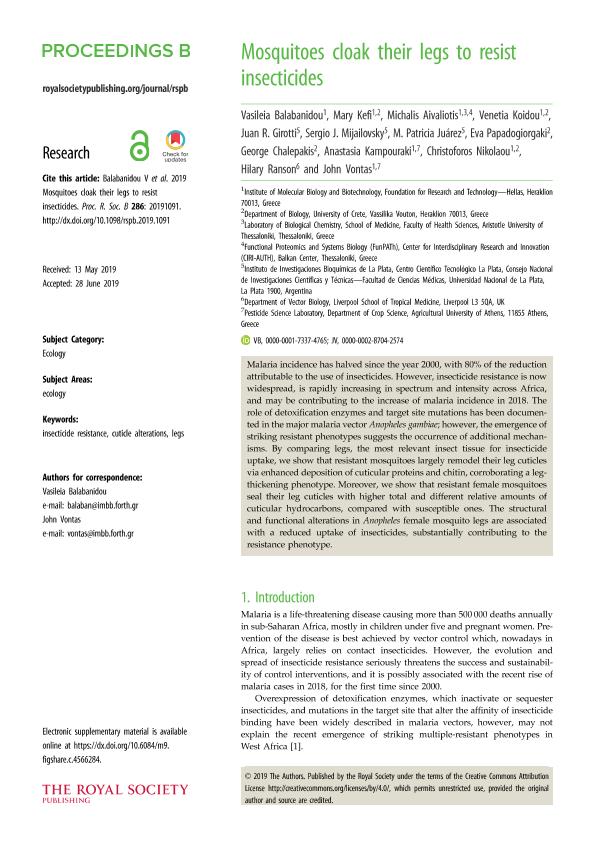Mostrar el registro sencillo del ítem
dc.contributor.author
Balabanidou, Vasileia

dc.contributor.author
Kefi, Mary
dc.contributor.author
Aivaliotis, Michalis
dc.contributor.author
Koidou, Venetia
dc.contributor.author
Girotti, Juan Roberto

dc.contributor.author
Mijailovsky, Sergio Javier

dc.contributor.author
Patricia Juárez, M.
dc.contributor.author
Papadogiorgaki, Eva
dc.contributor.author
Chalepakis, George
dc.contributor.author
Kampouraki, Anastasia
dc.contributor.author
Nikolaou, Christoforos
dc.contributor.author
Ranson, Hilary
dc.contributor.author
Vontas, John
dc.date.available
2021-01-20T02:17:01Z
dc.date.issued
2019-07-17
dc.identifier.citation
Balabanidou, Vasileia; Kefi, Mary; Aivaliotis, Michalis; Koidou, Venetia; Girotti, Juan Roberto; et al.; Mosquitoes cloak their legs to resist insecticides; The Royal Society; Proceedings of the Royal Society of London. Series B: Biological Sciences; 286; 1091; 17-7-2019; 1-9
dc.identifier.issn
0962-8452
dc.identifier.uri
http://hdl.handle.net/11336/123118
dc.description.abstract
Malaria incidence has halved since the year 2000, with 80% of the reduction attributable to the use of insecticides. However, insecticide resistance is now widespread, is rapidly increasing in spectrum and intensity across Africa, and may be contributing to the increase of malaria incidence in 2018. The role of detoxification enzymes and target site mutations has been documented in the major malaria vector Anopheles gambiae; however, the emergence of striking resistant phenotypes suggests the occurrence of additional mechanisms. By comparing legs, the most relevant insect tissue for insecticide uptake, we show that resistant mosquitoes largely remodel their leg cuticles via enhanced deposition of cuticular proteins and chitin, corroborating a leg-thickening phenotype. Moreover, we show that resistant female mosquitoes seal their leg cuticles with higher total and different relative amounts of cuticular hydrocarbons, compared with susceptible ones. The structural and functional alterations in Anopheles female mosquito legs are associated with a reduced uptake of insecticides, substantially contributing to the resistance phenotype.
dc.format
application/pdf
dc.language.iso
eng
dc.publisher
The Royal Society

dc.rights
info:eu-repo/semantics/openAccess
dc.rights.uri
https://creativecommons.org/licenses/by/2.5/ar/
dc.subject
CUTICLE ALTERATIONS
dc.subject
INSECTICIDE RESISTANCE
dc.subject
LEGS
dc.subject.classification
Bioquímica y Biología Molecular

dc.subject.classification
Ciencias Biológicas

dc.subject.classification
CIENCIAS NATURALES Y EXACTAS

dc.title
Mosquitoes cloak their legs to resist insecticides
dc.type
info:eu-repo/semantics/article
dc.type
info:ar-repo/semantics/artículo
dc.type
info:eu-repo/semantics/publishedVersion
dc.date.updated
2020-11-25T17:34:07Z
dc.journal.volume
286
dc.journal.number
1091
dc.journal.pagination
1-9
dc.journal.pais
Reino Unido

dc.journal.ciudad
Londres
dc.description.fil
Fil: Balabanidou, Vasileia. Institute of Molecular Biology And Biotechnology. Foundation For Research And Technology; Grecia
dc.description.fil
Fil: Kefi, Mary. University of Crete; Grecia. Institute Of Molecular Biology And Biotechnology, Foundation For Research And Technology; Grecia
dc.description.fil
Fil: Aivaliotis, Michalis. Institute Of Molecular Biology And Biotechnology, Foundation For Research And Technology; Grecia. Aristotle University of Thessaloniki; Grecia
dc.description.fil
Fil: Koidou, Venetia. Institute Of Molecular Biology And Biotechnology, Foundation For Research And Technology; Grecia. University of Crete; Grecia
dc.description.fil
Fil: Girotti, Juan Roberto. Consejo Nacional de Investigaciones Científicas y Técnicas. Centro Científico Tecnológico Conicet - La Plata. Instituto de Investigaciones Bioquímicas de La Plata "Prof. Dr. Rodolfo R. Brenner". Universidad Nacional de la Plata. Facultad de Ciencias Médicas. Instituto de Investigaciones Bioquímicas de La Plata "Prof. Dr. Rodolfo R. Brenner"; Argentina
dc.description.fil
Fil: Mijailovsky, Sergio Javier. Consejo Nacional de Investigaciones Científicas y Técnicas. Centro Científico Tecnológico Conicet - La Plata. Instituto de Investigaciones Bioquímicas de La Plata "Prof. Dr. Rodolfo R. Brenner". Universidad Nacional de la Plata. Facultad de Ciencias Médicas. Instituto de Investigaciones Bioquímicas de La Plata "Prof. Dr. Rodolfo R. Brenner"; Argentina
dc.description.fil
Fil: Patricia Juárez, M.. Consejo Nacional de Investigaciones Científicas y Técnicas. Centro Científico Tecnológico Conicet - La Plata. Instituto de Investigaciones Bioquímicas de La Plata "Prof. Dr. Rodolfo R. Brenner". Universidad Nacional de la Plata. Facultad de Ciencias Médicas. Instituto de Investigaciones Bioquímicas de La Plata "Prof. Dr. Rodolfo R. Brenner"; Argentina
dc.description.fil
Fil: Papadogiorgaki, Eva. University of Crete; Grecia
dc.description.fil
Fil: Chalepakis, George. University of Crete; Grecia
dc.description.fil
Fil: Kampouraki, Anastasia. Institute Of Molecular Biology And Biotechnology, Foundation For Research And Technology; Grecia. Agricultural University of Athens; Grecia
dc.description.fil
Fil: Nikolaou, Christoforos. Institute Of Molecular Biology And Biotechnology, Foundation For Research And Technology; Grecia. University of Crete; Grecia
dc.description.fil
Fil: Ranson, Hilary. Liverpool School of Tropical Medicine; Reino Unido
dc.description.fil
Fil: Vontas, John. Institute Of Molecular Biology And Biotechnology, Foundation For Research And Technology; Grecia. Agricultural University of Athens; Grecia
dc.journal.title
Proceedings of the Royal Society of London. Series B: Biological Sciences

dc.relation.alternativeid
info:eu-repo/semantics/altIdentifier/doi/http://dx.doi.org/10.1098/rspb.2019.1091
dc.relation.alternativeid
info:eu-repo/semantics/altIdentifier/url/https://royalsocietypublishing.org/doi/10.1098/rspb.2019.1091
Archivos asociados
